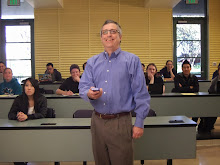We had a good mix of experts on the subject:
- Jon Fisher, serial entrepreneur, blogger and author of Strategic Entrepreneurism
- Gustavo Alberelli, director of Kennet Venture Partners that specializes in investing in bootstrap companies
- Ilya Ronin, a former software engineer and SJSU alumnus who is one of the three executives of bootstrapping Marpo Kinetics (an exercise machine company)
- Identify a customer need
- Build a product
- Sell the product
Jon Fisher purposely avoided raising venture capital in his ventures. His latest venture, Bharosa, was sold to Oracle for a 6X multiple in 3 years to his angel investors, a sweet close to triple digit IRR. His goal in building the company was to spend 3 years building value and find a good home for the engineers and product. In this case, a win-win for everyone, except perhaps the VCs who didn't get the opportunity to participate. Certainly not to say they couldn't have raised more cash and built this in to a bigger company, but was nice to have the option of going either way and doing what was right for the founders and employees.
Finally, Ilya Ronin, shared the Marpo Kinetics story, a true bootstrapped garage start-up. The three founders shared a vision, built the exercise machines in the garage, and knocked on doors at health clubs, attended trade shows, and worked the phone to get initial sales. We don't know the end of the story, but they have built a real business with hundres of machines sold to gyms all over the world along with government contracts for military purchases.
In this economy, all entrepreneurs are going to hear a lot of "no's", but time spent going after customers rather than investors should provide a higher return on investment. Of course, assuming you are successful in the first, the latter will certainly be an option in the future.
